Kyocera FS 9530DN User Manual

FS-9130DN
FS-9530DN
Advanced Operation Guide

Contents
Contents
1 |
Handling Paper........................................................................................................................... |
1-1 |
|
General Guidelines ..................................................................................................................... |
1-2 |
|
Special Paper .............................................................................................................................. |
1-9 |
|
Media Type ................................................................................................................................ |
1-13 |
|
Loading Paper ........................................................................................................................... |
1-14 |
2 |
Using the Operation Panel ........................................................................................................ |
2-1 |
|
Understanding the Operation Panel ............................................................................................ |
2-2 |
|
Canceling a Printing Job ........................................................................................................... |
2-10 |
|
Using the Operation Panel ........................................................................................................ |
2-11 |
|
Using the Menu Selection System ............................................................................................ |
2-19 |
|
Status Pages ............................................................................................................................. |
2-20 |
|
e-MPS ....................................................................................................................................... |
2-23 |
|
Changing the Interface Parameters .......................................................................................... |
2-35 |
|
Making Default Settings ............................................................................................................ |
2-42 |
|
Pagination ................................................................................................................................. |
2-51 |
|
Setting Print Quality .................................................................................................................. |
2-58 |
|
Operating the Storage Device ................................................................................................... |
2-62 |
|
Paper Handling ......................................................................................................................... |
2-73 |
|
Reading Life Counters .............................................................................................................. |
2-86 |
|
Other Modes ............................................................................................................................. |
2-87 |
3 |
Fonts ........................................................................................................................................... |
3-1 |
|
List of Fonts ................................................................................................................................. |
3-2 |
4 |
Options........................................................................................................................................ |
4-1 |
|
General Information .................................................................................................................... |
4-2 |
|
Network Interface ........................................................................................................................ |
4-6 |
|
Hard Disk .................................................................................................................................... |
4-8 |
|
CompactFlash (Memory) Card .................................................................................................. |
4-10 |
|
USB Flash Memory ................................................................................................................... |
4-11 |
|
Expansion Memory Modules ..................................................................................................... |
4-12 |
|
HDD Security Function .............................................................................................................. |
4-15 |
5 |
Computer Interface .................................................................................................................... |
5-1 |
|
General Information .................................................................................................................... |
5-2 |
|
Parallel Interface ......................................................................................................................... |
5-3 |
|
USB Interface .............................................................................................................................. |
5-5 |
|
Serial Interface (Option) .............................................................................................................. |
5-6 |
|
RS-232C Protocol ....................................................................................................................... |
5-7 |
|
RS-232C Cable Connection ...................................................................................................... |
5-10 |
Glossary
Index
ADVANCED OPERATION GUIDE |
i |

Contents
ii |
ADVANCED OPERATION GUIDE |

Introduction
This guide has the following chapters:
•1 Handling Paper
Explains how to choose, handle and load paper.
•2 Using the Operation Panel
Explains how to use the operation panel to configure the printer.
•3 Fonts
Shows the available fonts.
•4 Options
Shows the available options.
•5 Computer Interface
Describes the possible connections between the printer and your computer.
•Glossary
A Glossary of terms used is provided here.
ADVANCED OPERATION GUIDE |
iii |

Conventions
This manual uses the following conventions:
Convention |
Description |
|
Example |
|
|
|
|
|
|
Italic Typeface |
Used to emphasize a key |
|
Close the top cover. |
|
|
word, phrase or references to |
|
Refer to Toner Container |
|
|
additional information. |
|
Replacement on page 3-3. |
|
|
|
|
|
|
Courier Typeface |
Used to denote messages or |
|
Replace the waste toner box when |
|
|
names displayed on the |
|
the Check waste toner box |
|
|
operation panel. |
|
message is displayed. |
|
|
|
|
|
|
Bracket Bold Text |
Used to denote operation |
|
Press [Go]. |
|
Typeface |
panel keys. |
|
|
|
|
|
|
|
|
Bold Typeface |
Used to emphasize button or |
|
Click Next. |
|
|
items to be selected in dialog |
|
|
|
|
boxes, and titles displaying in |
|
|
|
|
dialog boxes. |
|
|
|
|
|
|
|
|
Notes |
Used to provide additional or |
|
|
|
NOTE: For information about storing |
|
|||
|
useful information about a |
|
|
|
|
function or feature. |
|
the pin, refer to step 10. |
|
|
|
|
|
|
|
|
|
|
|
Important |
Used to provide important |
|
|
|
IMPORTANT: Ensure paper is not |
|
|||
|
information. |
|
|
|
|
|
|
folded, curled, or damaged. |
|
|
|
|
|
|
Caution |
Cautions are statements that |
|
|
|
CAUTION: Do not pull the cassette |
|
|||
|
suggest mechanical damage |
|
|
|
|
as a result of an action. |
|
out when holding the front of the |
|
|
|
machine. |
|
|
|
|
|
|
|
|
|
|
|
|
|
|
|
|
|
Warning |
Used to alert users to the |
|
WARNING: High voltage is |
|
|
possibility of personal injury. |
|
present in the charger section. |
|
iv |
ADVANCED OPERATION GUIDE |

1 Handling Paper
This chapter explains the following topics:
• |
General Guidelines...................................................... |
1-2 |
• |
Special Paper .............................................................. |
1-9 |
• |
Media Type................................................................ |
1-13 |
• |
Loading Paper........................................................... |
1-14 |
ADVANCED OPERATION GUIDE |
1-1 |

Handling Paper
General Guidelines
The printer is designed to print on high-quality copier bond paper (the kind used in ordinary dry copier machines), but it can also accept a variety of other types of paper within the limits specified below.
NOTE: The manufacturer assumes no liability for problems that occur when paper not satisfying these requirements is used.
Selection of the right paper is important. Using the wrong paper can result in paper jams, misfeeding, curling, poor print quality, and paper waste, and in extreme cases can damage the printer. The guidelines given below will increase the productivity of your office by ensuring efficient, trouble-free printing and reducing wear and tear on the printer.
Paper Availability
Most types of paper are compatible with a variety of machines. Paper intended for xerographic copiers can also be used with the printer.
There are three general grades of paper: economy, standard, and premium. The most significant difference between grades is the ease with which they pass through the printer. This is affected by the smoothness, size, and moisture content of the paper, and the way in which the paper is cut. The higher the grade of paper you use, the less risk there will be of paper jams and other problems, and the higher the level of quality your printed output will reflect.
Differences between paper from different suppliers can also affect the printer’s performance. A high-quality printer cannot produce high-quality results when the wrong paper is used. Low-priced paper is not economical in the long run if it causes printing problems.
Paper in each grade is available in a range of basis weights (defined later). The traditional standard weights are 16, 20, and 28 pounds (60 to
105 g/m2).
1-2 |
ADVANCED OPERATION GUIDE |
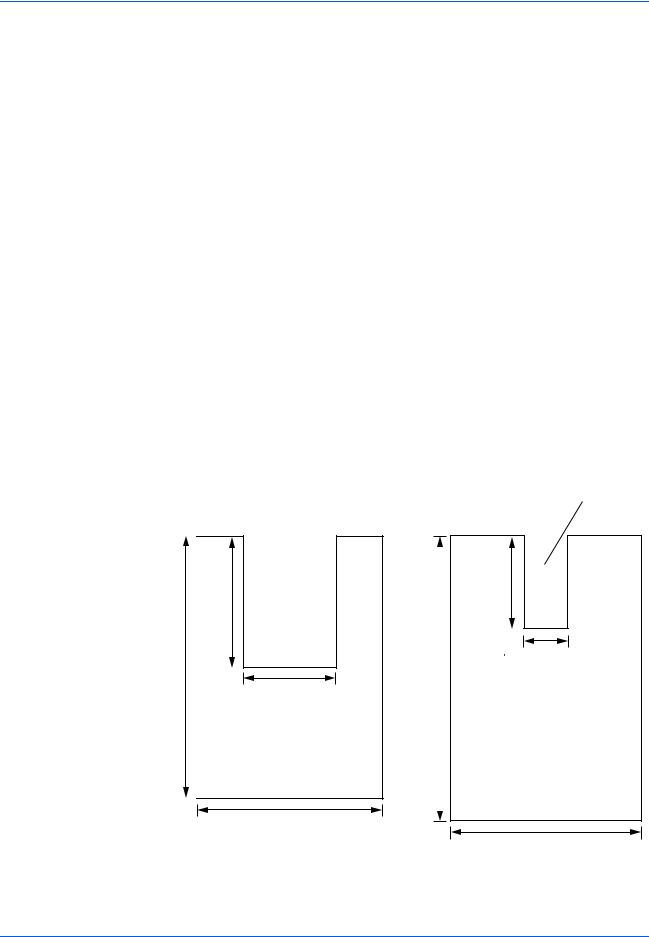
Handling Paper
Paper Specifications
The following table summarizes the basic paper specifications. Details are given on the following pages.
Item |
Specification |
|
|
Weight |
Cassette: 60 to 105 g/m2 |
|
(16 to 28 lb/ream) |
|
MP tray: 45 to 200 g/m2 |
|
(12 to 53 lb/ream) |
|
|
Thickness |
0.086 to 0.110 mm (3.4 to |
|
4.3 mils) |
|
|
Dimensional accuracy |
±0.7 mm (±0.0276 inches) |
|
|
Squareness of corners |
90° ±0.2° |
|
|
Moisture content |
4 to 6 % |
|
|
Direction of grain |
Long grain |
|
|
Pulp content |
80 % or more |
|
|
Minimum and maximum paper sizes
The minimum and maximum paper sizes are as follows. For non standard paper such as cut-sheet, the MP (multi-purpose) tray must be used.
Paper Cassette
432 mm 17 inches |
|
|
210 mm 8-1/4 inches |
|
|
|
|
Minimum
Paper
Size
148 mm
5-13/16 inches
450 mm 18 inches
Minimum
MP Tray Paper
Size
148 mm 5-13/16 inches
88 mm
3-7/16 inches
297 mm
11-11/16 inches
297 mm
11-11/16 inches
ADVANCED OPERATION GUIDE |
1-3 |

Handling Paper
Selecting the Right Paper
Laser printing is a process involving laser light, electrostatic discharge, toner, and heat. In addition, as the paper passes through the printer it undergoes considerable sliding, bending, and twisting motions. A highquality printing paper matching the printer’s requirements withstands all these stresses, enabling the printer to turn out clean, crisp printed copies consistently.
Remember that all paper is not the same. Some of the factors to consider when selecting paper for the printer are as follows:
Condition
Avoid using paper that is bent at the edges, curled, dirty, torn, embossed, or contaminated with lint, clay, or paper shreds.
Use of paper in these conditions can lead to illegible printing, misfeeding, and paper jams, and can shorten the life of the printer. In particular, avoid using paper with a surface coating or other surface treatment. The paper should have as smooth and even a surface as possible.
Composition
Do not use paper that has been coated or surface-treated and contains plastic or carbon. The heat of fusing can cause such paper to give off harmful fumes.
Bond paper should contain at least 80 % pulp. Not more than 20 % of the total paper content should consist of cotton or other fibers.
Paper Sizes
Cassettes and an MP tray are available for the paper sizes listed in the table below. The dimensional tolerances are ±0.7 mm (±0.0276 inches) for the length and width. The angle at the corners must be 90° ±0.2°.
MP tray |
Size |
Cassette or |
Size |
|
MP tray |
||||
|
|
|
||
|
|
|
|
|
Envelope |
3-7/8 × 7-1/2 inches |
Ledger |
11 × 17 inches |
|
Monarch |
|
|
|
|
|
|
|
|
|
Envelope #10 |
4-1/8 × 9-1/2 inches |
Legal |
8-1/2 × 14 inches |
|
|
|
|
|
|
Envelope #9 |
3-7/8 × 8-7/8 inches |
Letter |
8-1/2 × 11 inches |
|
|
|
|
|
|
Envelope #6 |
3-5/8 × 6-1/2 inches |
Statement |
5-1/2 × 8-1/2 inches |
|
|
|
|
|
|
Envelope DL |
110 × 220 mm |
Folio |
210 × 330 mm |
|
|
|
|
|
|
Envelope C5 |
162 × 229 mm |
A3 |
297 × 420 mm |
|
|
|
|
|
|
A6 |
105 × 148 mm |
A4 |
210 × 297 mm |
|
|
|
|
|
|
B6 |
128 × 182 mm |
A5 |
148 × 210 mm |
|
|
|
|
|
1-4 |
ADVANCED OPERATION GUIDE |

|
|
|
|
Handling Paper |
|
|
|
|
|
|
|
|
|
|
|
MP tray |
Size |
Cassette or |
Size |
|
MP tray |
|||
|
|
|
|
|
|
|
|
|
|
|
ISO B5 |
176 × 250 mm |
B4 |
257 × 364 mm |
|
|
|
|
|
|
Executive |
7-1/4 × 10-1/2 inches |
B5 |
182 × 257 mm |
|
|
|
|
|
|
Envelope C4 |
229 × 324 mm |
Oficio II |
8-1/2 × 13 inches |
|
|
|
|
|
|
Hagaki |
100 × 148 mm |
|
|
|
|
|
|
|
|
Oufuku Hagaki |
148 × 200 mm |
|
|
|
|
|
|
|
|
Youkei 2 |
114 × 162 mm |
|
|
|
|
|
|
|
|
Youkei 4 |
105 × 235 mm |
|
|
|
|
|
|
|
|
8K |
273 × 394 mm |
|
|
|
|
|
|
|
|
16K |
197 × 273 mm |
|
|
|
|
|
|
|
Paper with other sizes (custom sizes) can also be fed from the MP tray. The minimum size paper for manual feed is 88 × 148 mm (3-1/2 × 5-13/16 inches), fed lengthwise. The maximum size is 297 × 450 mm (11-11/16 × 17-3/4 inches).
Smoothness
The paper should have a smooth, uncoated surface. Paper with a rough or sandy surface can cause voids in the printed output. Paper that is too smooth, however, can cause multiple feeding and fogging problems. (Fogging is a gray background effect.)
Basis Weight
Basis weight is the weight of a standard quantity of paper. In the traditional system, the standard quantity is a ream consisting of 500 sheets measuring 17 × 22 inches each. In the metric system the standard quantity is 1 square meter.
Paper that is too light or too heavy can cause misfeeding, jams, and premature wear of the printer. Uneven paper weight can cause multiple feeds, print defects, poor toner fusing, blurring, and other print quality
problems. The proper weight is 60 to 105 g/m2 for the paper cassette, and 45 to 200 g/m2 for the MP tray.
ADVANCED OPERATION GUIDE |
1-5 |

Handling Paper
Paper Weight Equivalence Table
The paper weight is listed in pounds (lb) and metric grams per square meter (g/m2). The shaded part indicates the standard weight.
U. S. Bond Weight (lb) |
Europe Metric Weight (g/m2) |
16 |
60 |
|
|
17 |
64 |
|
|
20 |
75 |
|
|
21 |
80 |
|
|
22 |
81 |
|
|
24 |
90 |
|
|
27 |
100 |
|
|
28 |
105 |
|
|
32 |
120 |
|
|
34 |
128 |
|
|
36 |
135 |
|
|
39 |
148 |
|
|
42 |
157 |
|
|
43 |
163 |
|
|
47 |
176 |
|
|
53 |
199 |
|
|
Thickness (Caliper)
Thick paper is referred to as high-caliper paper and thin paper as lowcaliper paper. The paper used with the printer should be neither extremely thick nor extremely thin. If you are having problems with paper jams, multiple feeds, and faint printing, the paper you are using may be too thin. If you are having problems with paper jams and blurred printing, the paper may be too thick. The proper thickness is 0.086 to 0.110 mm (3.4 to
4.3 mils).
1-6 |
ADVANCED OPERATION GUIDE |

Handling Paper
Moisture Content
Moisture content is defined as the percent ratio of moisture to the dry mass of the paper. Moisture can affect the paper’s appearance, feedability, curl, electrostatic properties, and toner fusing characteristics.
The moisture content of the paper varies with the relative humidity in the room. When the relative humidity is high and the paper absorbs moisture, the paper edges expand, becoming wavy in appearance. When the relative humidity is low and the paper loses moisture, the edges shrink and tighten, and print contrast may suffer.
Wavy or tight edges can cause misfeeding and alignment anomalies. The moisture content of the paper should be 4 to 6%. To ensure the proper moisture content, it is important to store the paper in a controlled environment. Some tips on moisture control are:
•Store paper in a cool, dry location.
•Keep the paper in its wrapping as long as possible. Rewrap paper that is not in use.
•Store paper in its original carton. Place a pallet, etc., under the carton to separate it from the floor.
•After removing paper from storage, let it stand in the same room as the printer for 48 hours before use.
•Avoid leaving paper where it is exposed to heat, sunlight, or damp.
Paper Grain
When paper is manufactured, it is cut into sheets with the grain running parallel to the length (long grain) or parallel to the width (short grain). Short grain paper can cause feeding problems in the printer. All paper used in the printer should be long grain.
Other Paper Properties
Porosity: Refers to the density of the paper structure; that is, how openly or compactly the fibers are bonded.
Stiffness: Limp paper can buckle inside the printer, while paper that is too stiff may bind. Either way the result is a paper jam.
Curl: Most paper has a natural tendency to curl in one direction. The paper should be loaded so that the natural curl is downward, to counteract the upward curl imparted by the printer. Printed sheets will then come out flat. Most paper also has a top and bottom surface. Loading instructions are usually given on the paper package.
NOTE: If the paper is considerably curled in one direction, e.g. when the paper was used to print on one side, try to roll the paper in the opposite direction to counteract the curl. Printed sheets will then come out flat.
ADVANCED OPERATION GUIDE |
1-7 |

Handling Paper
Electrostatic properties: During the printing process, the paper is electrostatically charged to attract the toner. The paper must be able to release this charge so that printed sheets do not cling together in the output tray.
Whiteness: The contrast of the printed page depends on the whiteness of the paper. Whiter paper provides a sharper, brighter appearance.
Quality control: Uneven sheet size, corners that are not square, ragged edges, welded (uncut) sheets, and crushed edges and corners can cause the printer to malfunction in various ways. A quality paper supplier should take considerable care to ensure that these problems do not occur.
Packaging: Paper should be packed in a sturdy carton to protect it from damage during transport. Quality paper obtained from a reputable supplier is usually properly packaged.
1-8 |
ADVANCED OPERATION GUIDE |

Handling Paper
Special Paper
This section explains printing on special paper. The page printer can use the following types of special paper. In this case, set the media type according to the table below.
Paper type to be used |
Media type to be selected |
|
|
Colored paper |
Color |
|
|
Preprinted paper |
Preprinted |
|
|
Overhead projector |
Transparency |
transparencies |
|
|
|
Postcards |
Cardstock |
|
|
Envelopes |
Envelope |
|
|
Label |
Labels |
|
|
When using the above types of paper, be sure to use products that are specified for use with photocopiers and/or page printers. Feed paper other than colored paper or preprinted paper from the MP (multi-purpose) tray. Use paper that is sold specifically for use with copiers (heat-fusing type). Label paper and envelopes should not be placed in the cassette.
Since the composition and quality of special paper vary considerably, special paper is more likely than white bond paper to give trouble during printing. No liability will be assumed if moisture, etc., given off in printing on special paper causes harm to the machine or operator.
NOTE: Before purchasing any type of special paper, test a sample on the printer and check that print quality is satisfactory.
Specifications for each type of special paper are given below.
ADVANCED OPERATION GUIDE |
1-9 |
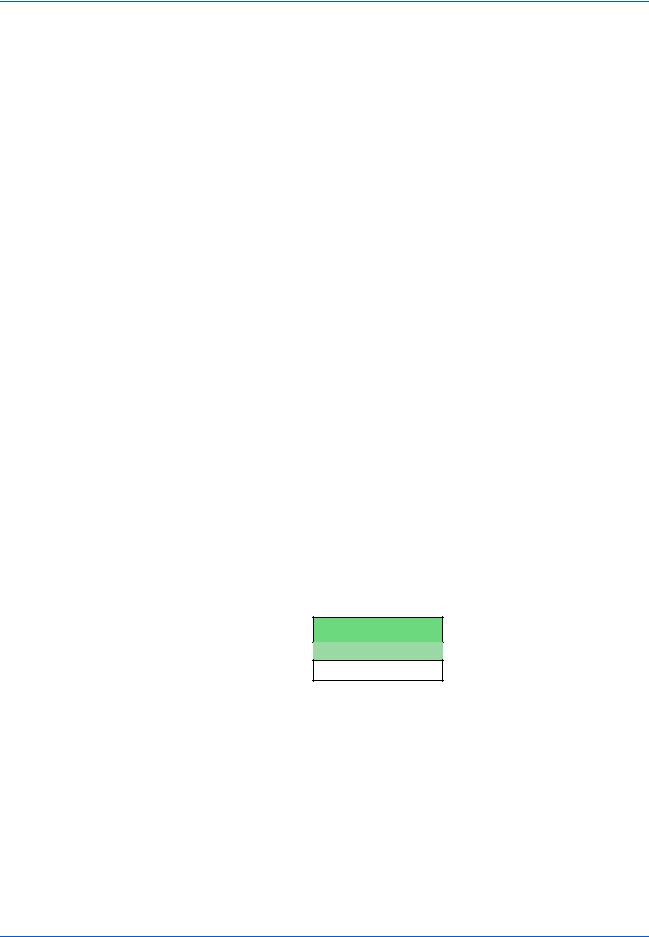
Handling Paper
Transparency
Transparency must be able to withstand the heat of fusing during the printing process. It should satisfy the conditions given in the table below.
Item |
Specification |
|
|
Tolerance of heat |
Must tolerate at least 190 °C |
|
(374 °F) |
|
|
Thickness |
0.100 to 0.110 mm (3.9 to |
|
4.3 mils) |
|
|
Material |
Polyester |
|
|
Dimensional accuracy |
±0.7 mm (±0.0276 inches) |
|
|
Squareness of corners |
90° ± 0.2° |
|
|
If transparency jams frequently, pull the top of the sheet very gently as it leaves the printer.
Adhesive-Backed Labels
The basic rule for printing on adhesive labels is that the adhesive must never come into contact with any part of the printer. Adhesive paper sticking to the drum or rollers will damage the printer.
Label paper must be manually fed.
Label paper has a structure comprised of three layers, as shown in the figure below. The top sheet is printed on. The adhesive layer consists of pressure-sensitive adhesives. The carrier sheet (also called the linear or backing sheet) holds the labels until use. Due to the complexity of its composition, adhesive-backed label paper is particularly likely to give trouble in printing.
Top sheet (White bond paper) Adhesive
Carrier sheet
Adhesive label paper must be entirely covered by its top sheet, with no spaces between the individual labels. Labels with spaces in between are apt to peel off, causing serious paper jam problems.
1-10 |
ADVANCED OPERATION GUIDE |

Handling Paper
Some label paper is manufactured with an extra margin of top sheet around the edge. Do not remove the extra top sheet from the carrier sheet until after printing is finished.
Acceptable |
Unacceptable |
|
Top |
|
sheet |
|
Carrier |
|
sheet |
The table below lists the specifications for adhesive label paper.
Item |
Specification |
|
|
Weight of top sheet |
44 to 74 g/m2 (12 to 20 lb/ream) |
Composite weight |
104 to 151 g/m2 |
|
(28 to 40 lb/ream) |
|
|
Thickness of top sheet |
0.086 to 0.107 mm |
|
(3.9 to 4.2 mils) |
|
|
Composite thickness |
0.115 to 0.145 mm |
|
(4.5 to 5.7 mils) |
|
|
Moisture content |
4 to 6 % (composite) |
|
|
Postcards
Fan the stack of postcards and align the edges before loading them in the MP tray. Make sure the postcards you are going to set are not curled. Feeding curled postcards may cause paper jams.
Some postcards have rough edges on the back (those are created when the paper is cut). In this case, put the postcards on a flat place and rub the edges with, for example, a ruler to smooth them.
Envelopes
The printer can print on envelopes using paper with a basis weight of 60 to 79 g/m2 (16 to 21 lb/ream). Envelopes must be manually fed.
An envelope is a more complex object than a single sheet of paper. For this reason, it may not be possible to obtain consistent print quality over the entire envelope surface.
Many envelopes have a diagonal grain orientation (Refer to Paper
Grain on page 1-7). This orientation is more likely to wrinkle and crease on its way through the printer. Before purchasing envelopes for use with the printer, test a sample to verify the envelope’s suitability.
ADVANCED OPERATION GUIDE |
1-11 |
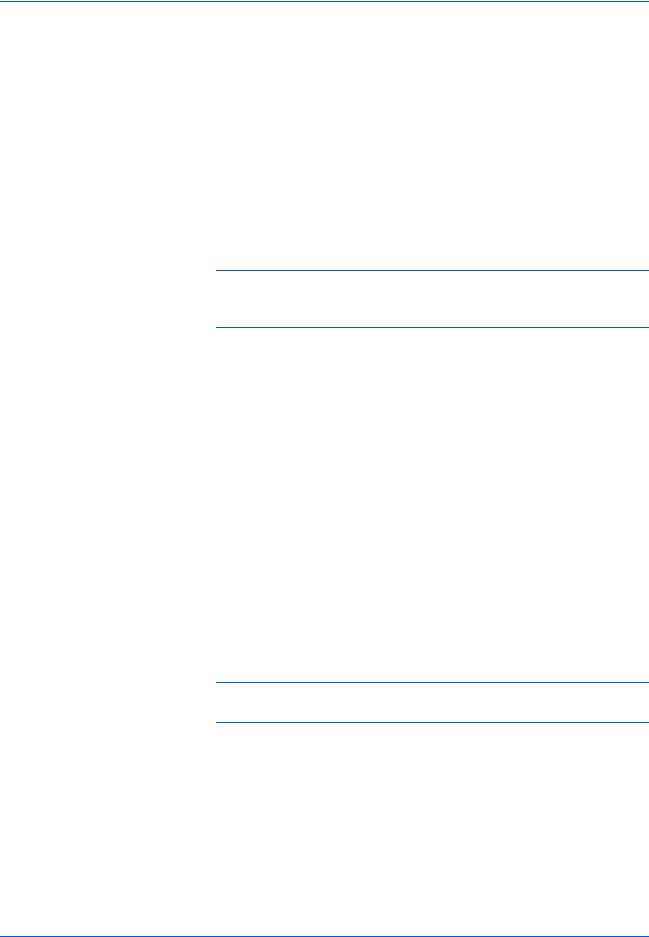
Handling Paper
Do not use envelopes that have an encapsulated liquid adhesive.
Avoid long printing runs consisting of envelopes only. Extensive envelope printing can cause premature printer wear. To avoid jamming due to curled envelopes, do not leave more than approximately 10 printed envelopes stacked in the paper trays during multiple envelope printing.
Thick Paper
Fan the stack of paper and align the edges before loading them in the MP tray. Some types of paper have rough edges on the back (those are created when the paper is cut). In this case, put the paper on a flat place and rub the edges once or twice with, for example, a ruler to smooth them. Feeding rough edged paper may cause paper jams.
NOTE: If the paper jams even after you smooth it out, load the paper in the MP Tray with the leading edge raised up a few millimeters as shown in the illustration.
Colored Paper
Colored paper should satisfy the same conditions as white bond paper, listed in Paper Specifications on page 1-3. In addition, the pigments used in the paper must be able to withstand the heat of fusing during the printing process (up to 200 °C or 392 °F).
Preprinted Paper
Preprinted paper should have a bond paper base. The preprinted ink must be able to withstand the heat of fusing during the printing process, and must not be affected by silicone oil.
Do not use paper with any kind of surface treatment, such as the type of paper commonly used for calendars.
Recycled Paper
Select recycled paper that meets the same specifications as the white bond paper (refer to Paper Specifications on page 1-3) except whiteness.
NOTE: Before purchasing recycled paper, test a sample on the printer and check that the print quality is satisfactory.
1-12 |
ADVANCED OPERATION GUIDE |
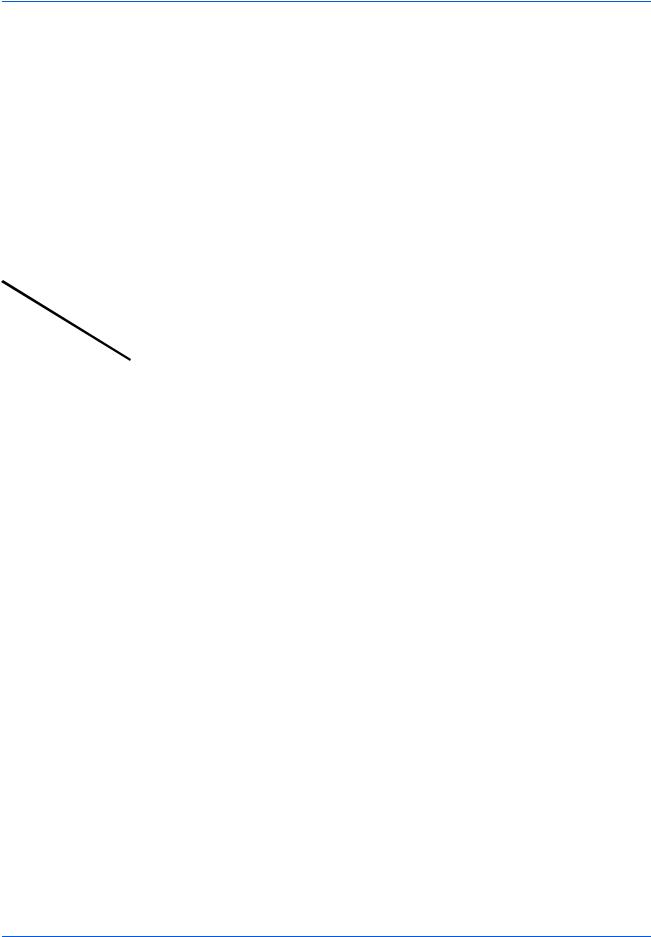
Handling Paper
Media Type
The printer is capable of printing under the optimum setting for the type of paper being used.
Setting the paper type for the paper source from the printer’s operation panel will cause the printer to automatically select the paper source and print in the mode best suited to that type of paper.
A different paper type setting can be made for each paper source including the MP tray. Not only can preset paper types be selected, but it is also possible for you to define and select customized paper types. Refer to
Creating Custom Paper Type on page 2-82.
The following types of paper can be set.
Paper source |
|
|
|
Duplex path |
|
MP tray |
Paper Cassette |
Paper Weight |
(MP tray available |
|
only in Cassette |
|||
|
|
|
|
|
Media Type |
|
|
|
mode) |
|
|
|
|
|
Plain |
Yes |
Yes |
Normal 2 |
Yes |
|
|
|
|
|
Transparency |
Yes |
No |
Extra Heavy |
No |
|
|
|
|
|
Preprinted |
Yes |
Yes |
Normal 2 |
Yes |
|
|
|
|
|
Labels |
Yes |
No |
Heavy 1 |
No |
|
|
|
|
|
Bond |
Yes |
Yes |
Normal 3 |
Yes |
|
|
|
|
|
Recycled |
Yes |
Yes |
Normal 2 |
Yes |
|
|
|
|
|
Vellum |
Yes |
Yes |
Light |
No |
|
|
|
|
|
Rough |
Yes |
Yes |
Normal 3 |
Yes |
|
|
|
|
|
Letterhead |
Yes |
Yes |
Normal 2 |
Yes |
|
|
|
|
|
Color |
Yes |
Yes |
Normal 2 |
Yes |
|
|
|
|
|
Prepunched |
Yes |
Yes |
Normal 2 |
Yes |
|
|
|
|
|
Envelope |
Yes |
No |
Heavy 2 |
No |
|
|
|
|
|
Cardstock |
Yes |
No |
Heavy 2 |
No |
|
|
|
|
|
Thick |
Yes |
No |
Heavy 2 |
No |
|
|
|
|
|
High quality |
Yes |
Yes |
Normal 2 |
Yes |
|
|
|
|
|
Custom 1 (to 8)* |
Yes |
Yes |
Normal 2 |
Yes |
|
|
|
|
|
Yes: Can be used |
No: Cannot be used |
|
|
|
|
|
|
|
|
*This is a paper type defined and registered by the user. Up to eight types of user settings may be defined. For details, refer to Creating Custom Paper Type on page 2-82.
ADVANCED OPERATION GUIDE |
1-13 |
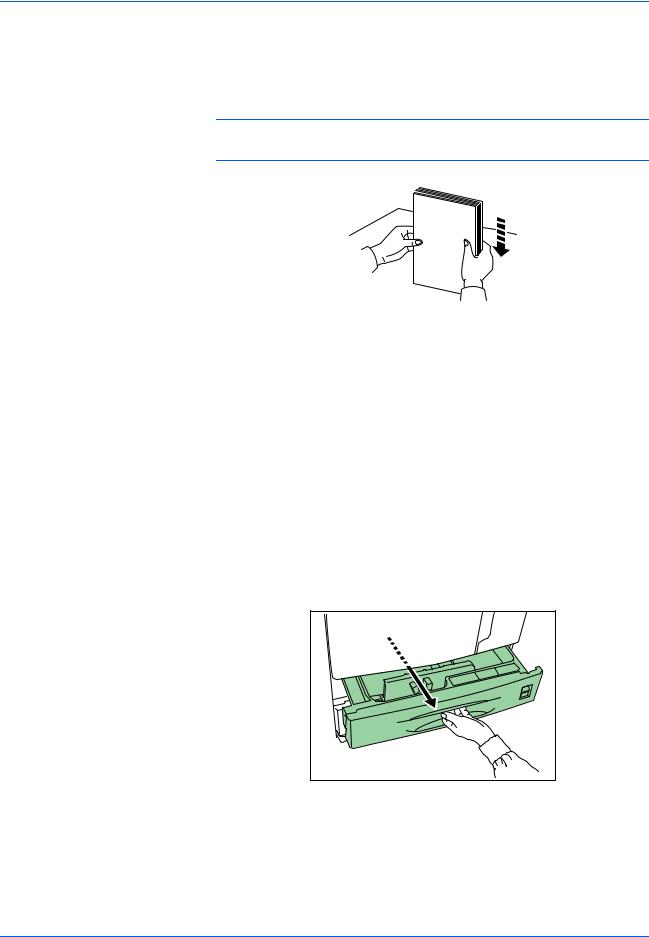
Handling Paper
Loading Paper
The following explains the produre for loading paper. Paper can be loaded into the two paper cassettes and the MP tray.
IMPORTANT: Fan the paper, then tap it on a level surface. This avoid media jams or skewed printing.
Loading Paper into the Paper Cassette
Up to about 500 sheets of standard paper (80 g/m2) can be loaded into the each paper cassette.
Inch specifications
Each paper cassette can be set to hold paper of any desired size from 11 × 17 to 5-1/2 × 8-1/2".
Metric specifications
Each paper cassette can be set to hold paper of any desired size from A3 to A5R.
1 |
Pull the paper cassette out toward you as far as it will go. Do not pull more |
|
|
|
than one paper cassette out at a time. |
1-14 |
ADVANCED OPERATION GUIDE |
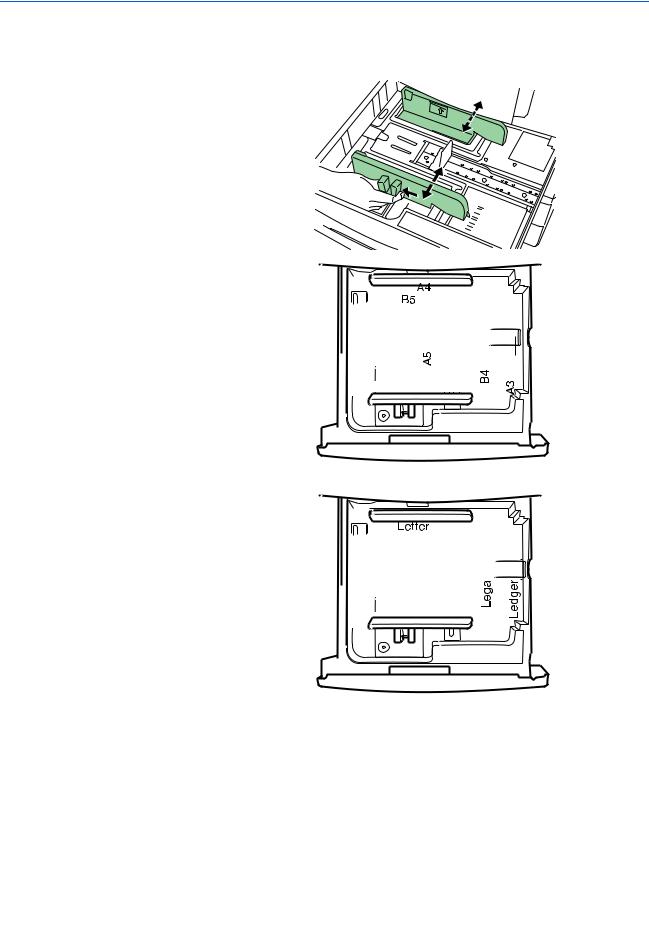
Handling Paper
2 |
Hold the paper guide and move it to align the paper guide with the required |
|||||||||||||||||||||||||
|
||||||||||||||||||||||||||
|
paper width. Paper sizes are marked inside the paper cassette. |
|||||||||||||||||||||||||
|
|
|
|
|
|
|
|
|
|
|
|
|
|
|
|
|
|
|
|
|
|
|
|
|
|
|
|
|
|
|
|
|
|
|
|
|
|
|
|
|
|
|
|
|
|
|
|
|
|
|
|
|
|
|
|
|
|
|
|
|
|
|
|
|
|
|
|
|
|
|
|
|
|
|
|
|
|
|
|
|
|
|
|
|
|
|
|
|
|
|
|
|
|
|
|
|
|
|
|
|
|
|
|
|
|
|
|
|
|
|
|
|
|
|
|
|
|
|
|
|
|
|
|
|
|
|
|
|
|
|
|
|
|
|
|
|
|
|
|
|
|
|
|
|
|
|
|
|
|
|
|
|
|
|
|
|
|
|
|
|
|
|
|
|
|
|
|
|
|
|
|
|
|
|
|
|
|
|
|
|
|
|
|
|
|
|
|
|
|
|
|
|
|
|
|
|
|
|
|
|
|
|
|
|
|
|
|
|
|
|
|
|
|
|
|
|
|
|
|
|
|
|
|
|
|
|
|
|
|
|
|
|
|
|
|
|
|
|
|
|
|
|
|
|
|
|
|
|
|
|
|
|
|
|
|
|
|
|
|
|
|
|
|
|
|
|
|
|
|
|
|
|
|
|
|
|
|
|
|
|
|
|
|
|
|
|
|
|
|
|
|
|
|
|
|
|
|
|
|
|
|
|
|
|
|
|
|
|
|
|
|
|
|
|
|
|
|
|
|
|
|
|
|
|
|
|
|
|
|
|
|
|
|
|
|
|
|
|
|
|
|
|
|
|
|
|
|
|
|
|
|
|
|
|
|
|
|
|
|
|
|
|
|
|
|
|
|
|
|
|
|
|
|
|
|
|
|
|
|
|
|
|
|
|
|
|
|
|
|
|
|
|
|
|
|
|
|
|
|
|
|
|
|
|
|
|
|
|
|
|
|
|
|
|
|
|
|
|
|
|
|
|
|
|
|
|
|
|
|
|
|
|
|
|
|
|
|
|
|
|
|
|
|
|
|
|
|
|
|
|
|
|
|
|
|
|
|
|
|
|
|
|
|
|
|
|
|
|
|
|
|
|
|
|
|
|
|
|
|
|
|
|
|
|
|
|
|
|
|
|
|
|
|
|
|
|
|
|
|
|
|
|
|
|
|
|
|
|
|
|
|
|
|
|
|
|
|
|
|
|
|
|
|
|
|
|
|
|
|
|
|
|
|
|
|
|
|
|
|
|
|
|
|
|
|
|
|
|
|
|
|
|
|
|
|
|
|
|
|
|
|
|
|
|
|
|
|
|
|
|
|
|
|
|
|
|
|
|
|
|
|
|
|
|
|
|
|
|
|
|
|
|
|
|
|
|
|
|
|
|
|
|
|
|
|
|
|
|
|
|
|
|
|
|
|
|
|
|
|
|
|
|
|
|
|
|
|
|
|
|
|
|
|
|
|
|
|
|
|
|
|
|
|
|
|
|
|
|
|
|
|
|
|
|
|
|
|
|
|
|
|
|
|
|
|
|
|
|
|
|
|
|
|
|
|
|
|
|
|
|
|
|
|
|
|
|
|
|
|
|
|
|
|
|
|
|
|
|
|
|
|
|
|
|
|
|
|
|
|
|
|
|
|
|
|
|
|
|
|
|
|
|
|
|
|
|
|
|
|
|
|
|
|
|
|
|
|
|
|
|
|
|
|
|
|
|
|
|
|
|
|
|
|
|
|
|
|
|
|
|
|
|
|
|
|
|
|
|
|
|
|
|
|
|
|
|
|
|
|
|
|
|
|
|
|
|
|
|
|
|
|
|
|
|
|
|
|
|
|
|
|
|
|
|
|
|
|
|
|
ADVANCED OPERATION GUIDE |
1-15 |
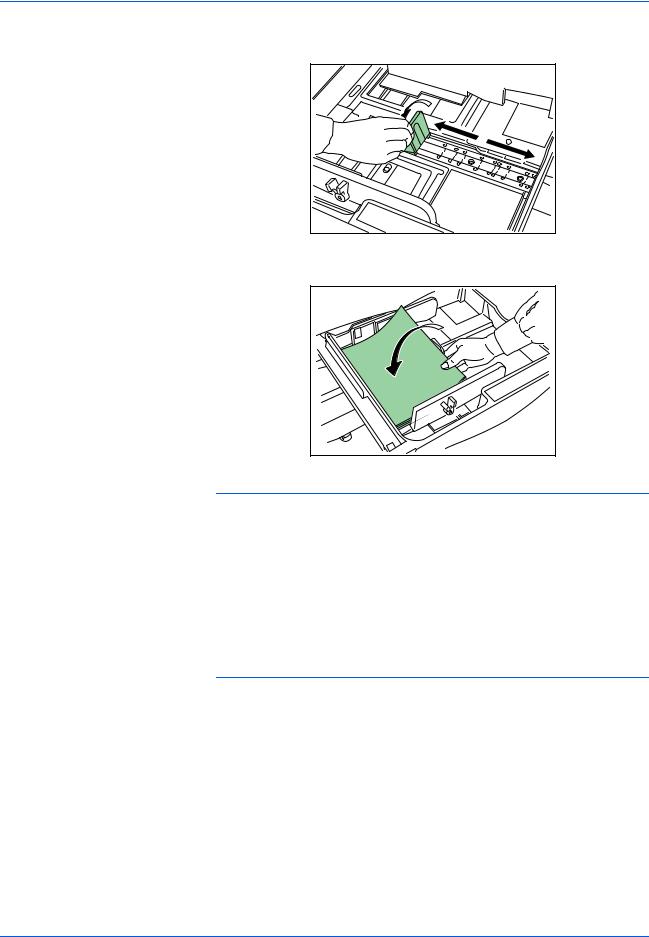
Handling Paper
3
4
Hold the paper stopper and move it to align with the required paper length.
Set the paper flush against the left-hand wall of the paper cassette.
IMPORTANT:There is a sticker ( in the illustration) indicating paper capacity attached to the inside of the paper cassette. Do not load paper above this limit.
in the illustration) indicating paper capacity attached to the inside of the paper cassette. Do not load paper above this limit.
When loading paper into the paper cassette, make sure that the print side is facing upward. (The print side is the side facing upward when the package is opened.)
Check that the paper guide makes secure contact with the paper. If there is a gap, adjust the position of the paper guide.
If small-size paper jams occur frequently under high temperature and high humidity conditions, reduce the number of sheets to the level line indicated on the sticker  .
.
1-16 |
ADVANCED OPERATION GUIDE |

Handling Paper
5 |
Set the supplied paper size plate so that the size of the paper loaded can |
||
|
|||
|
be checked by looking at the front of the paper cassette. |
||
|
|
|
|
|
|
|
|
6 |
Push the paper cassette back until it stops. |
|
|
|
|
|
NOTE: Before leaving the printer in disuse for a prolonged period of time, |
|
remove the paper from the paper cassette(s) and seal it in its original |
|
packaging to protect from moisture. Also, when storing paper in a high |
|
temperature and high humidity environment, seal it in a moisture-proof |
|
bag. |
|
|
ADVANCED OPERATION GUIDE |
1-17 |
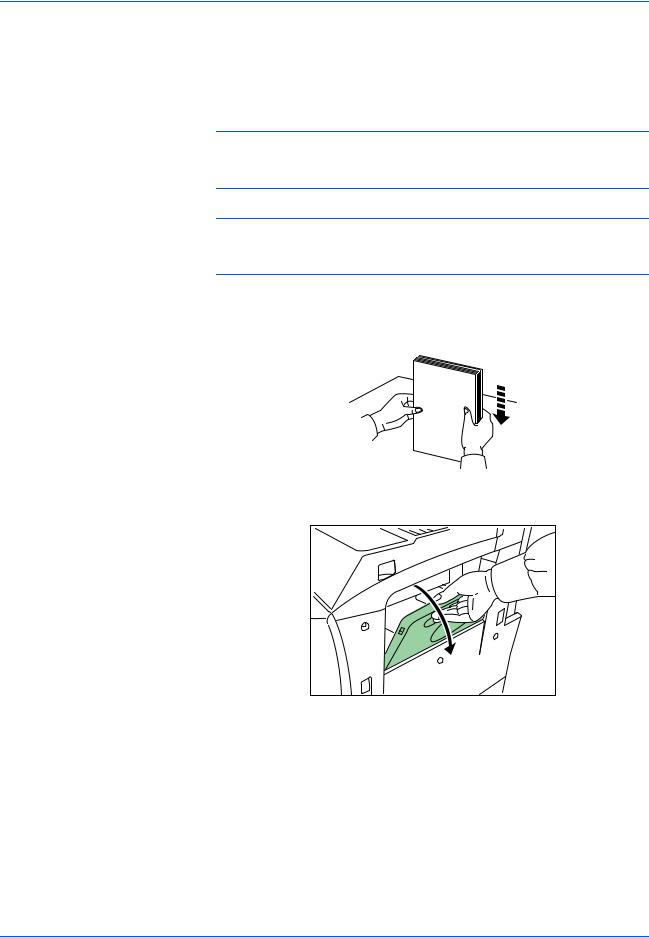
Handling Paper
Loading Paper into the MP (Multi-Purpose) Tray
Special paper as well as standard paper can be loaded into the MP tray. When printing onto transparencies or thick paper, be sure to use the MP tray.
IMPORTANT: When setting special paper, such as transparencies and thick paper, into the MP tray, select the type of paper by referring to Media Type on page 1-13.
NOTE: The number of sheets of standard paper that can be loaded in the MP tray at a time is approximately 200. When using transparencies, load a single sheet at a time.
1 |
Fan the paper, then tap it on a level surface to avoid media jams or skewed |
|
|
|
printing. |
2 |
Open the MP tray. |
|
1-18 |
ADVANCED OPERATION GUIDE |
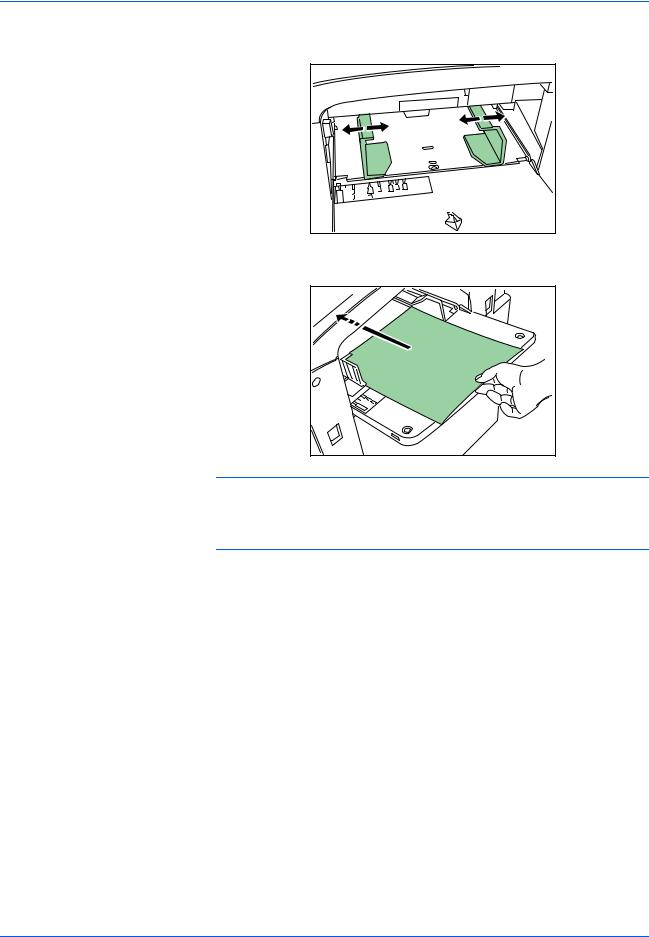
Handling Paper
3
4
Adjust the insert guides to the size of the paper to be loaded.
Insert the paper along the guides as far as it will go.
IMPORTANT: When loading paper into the MP tray, make sure that the print side is facing upward. (The print side is the side facing upward when the package is opened.) If the leading edge of the paper is curled, straighten it out before loading the paper in the MP tray.
ADVANCED OPERATION GUIDE |
1-19 |

Handling Paper
Setting Envelopes
When using the optional printer function, envelopes can be set in the MP tray.
NOTE: Do not print on envelopes with flap adhesive exposed. This can cause printer malfunction.
1 |
Open the MP tray. |
|
2 |
Align the insert guides with the envelope size. |
|
3 |
Position the envelope against the insert guides with the print side facing |
|
|
|
upward, and insert it as far as it will go. |
1-20 |
ADVANCED OPERATION GUIDE |
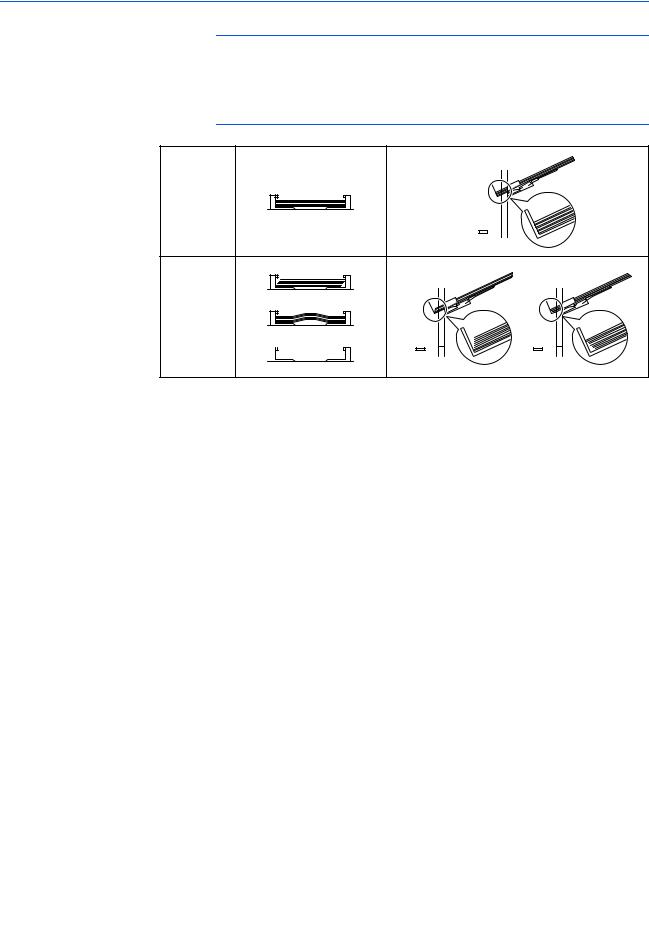
Handling Paper
NOTE: Do not load more paper than will fit under the load limits on the inside of the MP tray. If the paper is considerably curled in one direction, for example, if the paper is already printed on one side, try to roll the paper in the opposite direction to counteract the curl. Printed sheets will then come out flat.
Correct
Incorrect
|
|
|
|
|
|
|
|
|
|
|
|
|
|
|
|
|
|
|
|
|
|
|
|
|
|
|
|
|
|
|
|
|
|
|
|
|
|
|
|
|
|
|
|
|
|
|
|
|
|
|
|
|
|
|
|
|
|
|
|
|
|
|
ADVANCED OPERATION GUIDE |
1-21 |
|||||||

Handling Paper
1-22 |
ADVANCED OPERATION GUIDE |

2Using the Operation Panel
This chapter explains the following topics: |
|
|
• Understanding the Operation Panel ............................ |
2-2 |
|
• Canceling a Printing Job ........................................... |
2-10 |
|
• Using the Operation Panel ......................................... |
2-11 |
|
• Using the Menu Selection System ............................ |
2-19 |
|
• |
Status Pages ............................................................. |
2-20 |
• |
e-MPS ....................................................................... |
2-23 |
• Changing the Interface Parameters .......................... |
2-35 |
|
• |
Making Default Settings ............................................ |
2-42 |
• |
Pagination ................................................................. |
2-51 |
• |
Setting Print Quality................................................... |
2-58 |
• Operating the Storage Device ................................... |
2-62 |
|
• |
Paper Handling.......................................................... |
2-73 |
• |
Reading Life Counters............................................... |
2-86 |
• |
Other Modes.............................................................. |
2-87 |
ADVANCED OPERATION GUIDE |
2-1 |
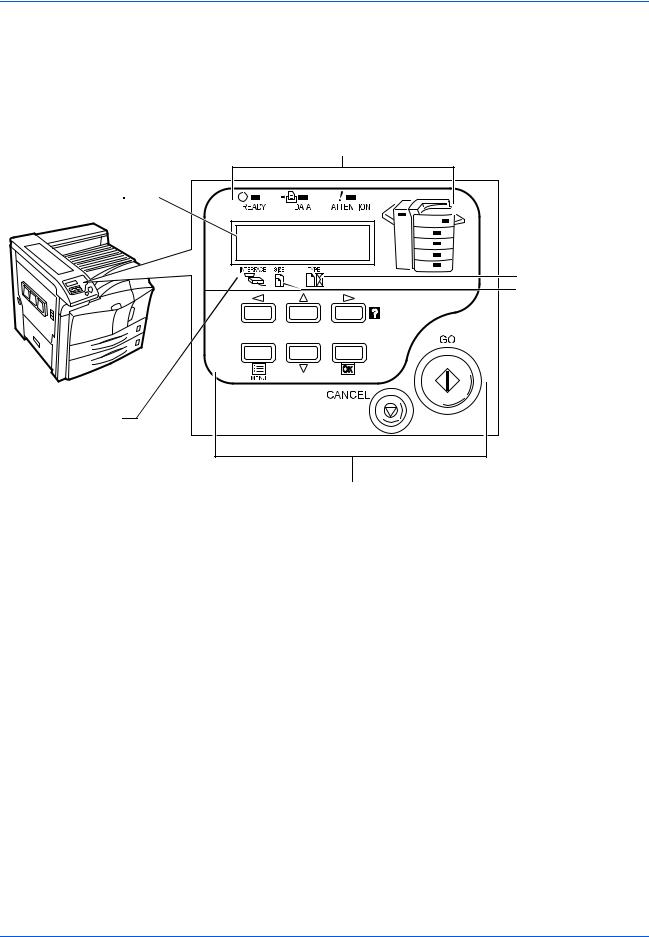
Using the Operation Panel
Understanding the Operation Panel
The operation panel has an LCD message display, indicators, and eight keys.
Operation Indicators (Refer to page 2-3)
Message Display (Refer to page 2-4) 
 Ready
Ready
--- A4 PLAIN
Paper Type Indicator (Refer to page 2-7) Paper Size Indicator (Refer to page 2-5)
Interface Indicator (Refer to page 2-5)
Keys (Refer to page 2-8)
2-2 |
ADVANCED OPERATION GUIDE |
